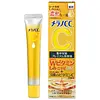What's inside
What's inside
 Key Ingredients
Key Ingredients

 Benefits
Benefits

 Concerns
Concerns

 Ingredients Side-by-side
Ingredients Side-by-side

Water
Skin ConditioningEthoxydiglycol
HumectantPropanediol
SolventSqualane
EmollientGlycerin
HumectantPropylene Glycol
HumectantPolyacrylate Crosspolymer-6
Emulsion StabilisingAscorbic Acid
AntioxidantOlea Europaea Fruit Oil
MaskingHaematococcus Pluvialis Extract
AntioxidantGlycine Max Oil
EmollientTocopherol
AntioxidantPEG-12 Dimethicone
Skin ConditioningDimethicone
EmollientPhenoxyethanol
PreservativeFerulic Acid
AntimicrobialSodium Metabisulfite
AntioxidantSodium Hydroxide
BufferingSodium Chloride
MaskingParfum
MaskingEthylhexylglycerin
Skin ConditioningDisodium EDTA
Citric Acid
BufferingWater, Ethoxydiglycol, Propanediol, Squalane, Glycerin, Propylene Glycol, Polyacrylate Crosspolymer-6, Ascorbic Acid, Olea Europaea Fruit Oil, Haematococcus Pluvialis Extract, Glycine Max Oil, Tocopherol, PEG-12 Dimethicone, Dimethicone, Phenoxyethanol, Ferulic Acid, Sodium Metabisulfite, Sodium Hydroxide, Sodium Chloride, Parfum, Ethylhexylglycerin, Disodium EDTA, Citric Acid
Ascorbic Acid
AntioxidantPyridoxine Hcl
Skin ConditioningAllantoin
Skin ConditioningIsopropylparaben
Preservative2-O-Ethyl Ascorbic Acid
Skin ConditioningAscorbyl Tetraisopalmitate
AntioxidantTocopherol
AntioxidantAlpinia Oxyphylla Seed Extract
Skin ConditioningCitrus Limon Leaf Extract
PerfumingCitrus Grandis Leaf Extract
AstringentSerine
MaskingButylene Glycol
HumectantPropanediol
SolventPPG-3 Methyl Ether
SolventButane
PEG-8
HumectantRosa Centifolia Flower Extract
AstringentDecyltetradeceth-25
EmulsifyingParfum
MaskingAscorbic Acid, Pyridoxine Hcl, Allantoin, Isopropylparaben, 2-O-Ethyl Ascorbic Acid, Ascorbyl Tetraisopalmitate, Tocopherol, Alpinia Oxyphylla Seed Extract, Citrus Limon Leaf Extract, Citrus Grandis Leaf Extract, Serine, Butylene Glycol, Propanediol, PPG-3 Methyl Ether, Butane, PEG-8, Rosa Centifolia Flower Extract, Decyltetradeceth-25, Parfum
 Reviews
Reviews

Ingredients Explained
These ingredients are found in both products.
Ingredients higher up in an ingredient list are typically present in a larger amount.
Ascorbic Acid is is pure Vitamin C. This form makes up the largest amount of vitamin C found naturally in our skin.
Not only is vitamin C great for your overall health and immune system, it also has plenty of benefits on your skin.
Vitamin C is best used for brightening skin. It improves dark spots, acne scars, and hyperpigmentation. This is because it blocks the process of skin darkening when exposed to UV.
Remember: Vitamin C should not replace sunscreen!
Your skin uses vitamin C to build collagen. Collagen is one key component in having a strong skin barrier and plump skin. Vitamin C also plays a role in regulating collagen, thus making it effective in improving wrinkles and fine lines.
Ascorbic acid shows potent antioxidant activity. As an antioxidant, it helps fight free-radicals. Free-radicals are molecules that may damage your skin cells. These antioxidants also protect skin against UV damage.
The best formulations include Vitamin E and/or ferulic acid. These two ingredients help stabilize and provide a boost in the benefits of ascorbic acid. This is because ascorbic acid becomes unstable when exposed to UV and air. In fact, you can tell your ascorbic acid has oxidized when it turns an orange-yellow color.
Ascorbic acid is generally compatible with other ingredients. However, using ascorbic acid with other active ingredients might cause irritation. Two ingredients: copper ions and benzoyl peroxide, will inactivate ascorbic acid completely.
Read more about other types of Vitamin C:
Foods rich with vitamin C include oranges, strawberries, broccoli, bell peppers, and more. When consuming Vitamin C, your skin receives a portion of the nutrients.
Learn more about Ascorbic AcidParfum is a catch-all term for an ingredient or more that is used to give a scent to products.
Also called "fragrance", this ingredient can be a blend of hundreds of chemicals or plant oils. This means every product with "fragrance" or "parfum" in the ingredients list is a different mixture.
For instance, Habanolide is a proprietary trade name for a specific aroma chemical. When used as a fragrance ingredient in cosmetics, most aroma chemicals fall under the broad labeling category of “FRAGRANCE” or “PARFUM” according to EU and US regulations.
The term 'parfum' or 'fragrance' is not regulated in many countries. In many cases, it is up to the brand to define this term.
For instance, many brands choose to label themselves as "fragrance-free" because they are not using synthetic fragrances. However, their products may still contain ingredients such as essential oils that are considered a fragrance by INCI standards.
One example is Calendula flower extract. Calendula is an essential oil that still imparts a scent or 'fragrance'.
Depending on the blend, the ingredients in the mixture can cause allergies and sensitivities on the skin. Some ingredients that are known EU allergens include linalool and citronellol.
Parfum can also be used to mask or cover an unpleasant scent.
The bottom line is: not all fragrances/parfum/ingredients are created equally. If you are worried about fragrances, we recommend taking a closer look at an ingredient. And of course, we always recommend speaking with a professional.
Learn more about ParfumPropanediol is an all-star ingredient. It softens, hydrates, and smooths the skin.
It’s often used to:
Propanediol is not likely to cause sensitivity and considered safe to use. It is derived from corn or petroleum with a clear color and no scent.
Learn more about PropanediolTocopherol (also known as Vitamin E) is a common antioxidant used to help protect the skin from free-radicals and strengthen the skin barrier. It's also fat soluble - this means our skin is great at absorbing it.
Vitamin E also helps keep your natural skin lipids healthy. Your lipid skin barrier naturally consists of lipids, ceramides, and fatty acids. Vitamin E offers extra protection for your skin’s lipid barrier, keeping your skin healthy and nourished.
Another benefit is a bit of UV protection. Vitamin E helps reduce the damage caused by UVB rays. (It should not replace your sunscreen). Combining it with Vitamin C can decrease sunburned cells and hyperpigmentation after UV exposure.
You might have noticed Vitamin E + C often paired together. This is because it is great at stabilizing Vitamin C. Using the two together helps increase the effectiveness of both ingredients.
There are often claims that Vitamin E can reduce/prevent scarring, but these claims haven't been confirmed by scientific research.
Learn more about Tocopherol